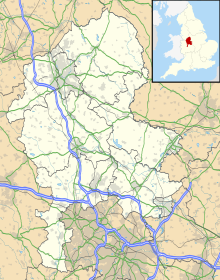Tatenhill Airfield
|
Tatenhill Airfield/RAF Tatenhill |
|||||||||||
|---|---|---|---|---|---|---|---|---|---|---|---|
| Summary | |||||||||||
| Airport type | Private | ||||||||||
| Operator | Tatenhill Aviation Limited | ||||||||||
| Location | Tatenhill, Staffordshire | ||||||||||
| Elevation AMSL | 439 ft / 134 m | ||||||||||
| Coordinates | 52°48′51″N 001°45′53″W / 52.81417°N 1.76472°WCoordinates: 52°48′51″N 001°45′53″W / 52.81417°N 1.76472°W | ||||||||||
| Website | [1] Flying at Tatenhill | ||||||||||
| Map | |||||||||||
| Location in Staffordshire | |||||||||||
| Runways | |||||||||||
|
|||||||||||
Tatenhill Airfield (ICAO: EGBM), previously Royal Air Force (RAF) Crossplains and later RAF Tatenhill, is a licensed airfield operated by Tatenhill Aviation Ltd, about 5 nautical miles (9 km; 6 mi) west of Burton upon Trent, Staffordshire, England. It is part of the Needwood Survey, a 3000 hectare (12 sq miles) estate held by the Duchy of Lancaster in the area of the former Needwood Forest.
The airfield has a CAA Ordinary Licence (Number P813) that allows flights for the public transport of passengers or for flying instruction as authorised by the licensee (Tatenhill Aviation).
Construction of the airfield was completed in 1941 during the Second World War, using the standard RAF specification of three co-intersecting runways. During the construction phase Miles Magister aircraft of No. 16 Elementary Flying Training School from RAF Burnaston used part of the airfield as a Relief Landing Ground. From 1941 until 1942 the airfield was a satellite for RAF Lichfield where No. 27 Operational Training Unit, Bomber Command used Vickers Wellington and Avro Anson aircraft. From 1942 until 1943 No. 15 (Pilot) Advanced Flying Training Unit, Flying Training Command used the Airspeed Oxford. From 1943 until 1944 No. 5 (P) AFU used the Miles Master. From 1944 until 1945 No. 21 (P) AFU used the Airspeed Oxford, this was to be the last RAF flying unit. During 1944 No. 21 Maintenance Unit arrived after the disastrous explosion at their nearby station of RAF Fauld. The airfield finally housed the RAF School of Explosives from 1945 until 1947. The RAF had completely moved out by 1950 and the airfield became disused. Many of the buildings and structures from this period were extant in 2015.
...
Wikipedia

